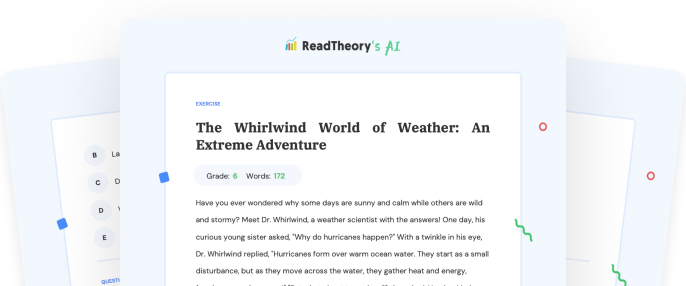Transform Your Teaching
with AI-Powered Worksheets
With ReadTheory’s Instant Worksheet Builder, you can create engaging, grade-appropriate worksheets tailored to your students in minutes. Spark curiosity, save time, and empower critical thinking with AI-powered tools designed for teachers like you.


The Terror and Wonder of Space: A Duality
Space, the final frontier, is an immense canvas where terror and wonder coexist. Its vastness, filled with countless stars and unexplored galaxies, is both overwhelming and awe-inspiring. As we gaze at the night sky, we marvel at the potential for discovering new life forms but also fear the risk of losing ourselves in its infinite expanse.
Space exploration has been a testament to human courage and intellect. Iconic missions like the Apollo moon landing have left footprints on the moon, while tragedies like the Challenger disaster remind us of the perils that accompany this bold endeavor. Our rovers tread on Mars, and probes venture to the outer edges of the solar system, pushing the boundaries of what we perceive as possible.
The wondrous phenomena of space, like the ethereal shimmer of comets, the explosive beauty of supernovas, and the mesmerizing dance of the northern lights, captivate us. Yet, its dangers, like the inescapable pull of black holes and the unpredictable paths of asteroid fields, invoke a sense of terror.
Space holds a mirror to our existence, reflecting our insignificance in its vastness and our resilience in exploration. It paints a picture that is terrifying and beautiful, a testament to the duality of the universe.
Question 1
What does the 'final frontier' refer to in the given paragraph?
The end of the universe
The edge of a galaxy
A mission to Mars
An asteroid field
Space
Question 2
What might be the author's purpose in describing the moon landing and the Challenger disaster together?
To show that space exploration is not worth the risks
To demonstrate that all space missions are bound to fail
To depict the duality of the universe
To highlight the courage and intellect of astronauts
To balance the achievements and dangers of space exploration
Question 3
What is the central idea of the text?
Space exploration is a waste of time and resources
The universe is filled with terror and wonder
Human beings are insignificant in the universe
Life exists in other galaxies
The dangers of space far outweigh its beauty
Question 4
Based on the information in the text, what can be inferred about black holes?
They are predictable
They are a source of light
They are the most beautiful phenomena in space
They have an inescapable pull
They can be easily explored
Question 5
Which statement is true according to the text?
All asteroids follow predictable paths
Comets are the only beautiful phenomena in space
Exploring Mars is an impossible task
The vastness of space is awe-inspiring
The moon landing was a disaster
 or share via
or share via

Assign the ReadTheory pretest to determine students' reading levels.

Why Teachers Love
Instant Worksheet Builder?

Tailored Content for Every Student
Craft worksheets with passages and multiple-choice questions customized to your chosen topic and grade level, ensuring relevance and engagement.

Save Hours
of Prep Time
Our AI, Lexi, generates complete worksheets—passages, questions, and answers—in minutes, freeing you to focus on teaching, not planning.

Standards-Aligned Learning
Every worksheet is designed to boost reading comprehension and critical thinking, aligning seamlessly with State Standards to help your students shine.
Personalized teaching
for personalized learning
Browse worksheets created and refined by educators using Lexi—your source for inspiration and ready-to-use resources.


ReadTheory is free for Teachers to use.
Join thousands of educators using ReadTheory for free. Sign up today and start creating in just minutes!





